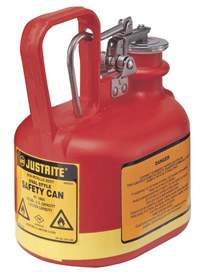



Find all of your laboratory and workplace safety supplies at Safety Emporium!
 Vapor |
 Glossary Index |
 Ventilation |
| MSDS Topics |
Free Sites | FAQ's | Regulations | Glossary | Software | Suppliers |
| Books | Forum | Poll | Fun stuff | Quiz | Store | |
| Understand your MSDS with the MS-Demystifier | Search ALL our MSDS info | |||||
The vapor pressure of a liquid is the pressure exerted by its vapor when the liquid and vapor are in dynamic equilibrium.
If we were to place a substance in an evacuated, closed container, some of it would vaporize. The pressure in the space above the liquid would increase from zero and eventually stabilize at a constant value, the vapor pressure.
It is important to specify the temperature when stating a vapor pressure because vapor pressures increase with temperature. Also, be aware that there are several different units for pressure.
Finally, recognize that liquids that aren't in a closed container still have a vapor pressure. However, the material will eventually evaporate or vaporize (turn into a gas) completely.
Even though the pressure in our closed container is constant, molecules of the vapor are still condensing into the liquid phase and molecules of the liquid are still evaporating into the vapor phase. However, the rate of these two processes is equal, so there is no net change in the amount of vapor or liquid. Chemists call this process called dynamic equilibrium and the term equilibrium vapor pressure is sometimes used.
Vapor pressure and boiling point have an intimate relationship. The boiling point is the temperature at which the vapor pressure of the liquid equals the external pressure. For example, because the air pressure the boiling point of water in a city far above sea level such as Denver (202 °F) is lower than in a sea level city such as New York (212 °F).
The most common unit for vapor pressure is the torr. 1 torr = 1 mm Hg (one millimeter of mercury).
Most materials have very low vapor pressures. For example, water has a vapor pressure of approximately 20 torr at room temperature (22 °C = 72 °F). But remember that vapor pressures increase with temperature; water will have a vapor pressure of 760 torr = 1 atm at its boiling point of 100 oC (212 oF).
In general, the higher the vapor pressure of a material at a given temperature, the lower the boiling point. In other words, compounds with high vapor pressures are volatile, forming a high concentration of vapor above the liquid; this can sometimes pose a fire hazard.

Store and dispense flammable liquids safely with flammable liquid safety cans from Safety Emporium.
Safety Data Sheets are required to state the vapor pressure of the material (if known and applicable) in Section 9 (physical and chemical properties). Depending on its vapor pressure, a volatile substance can easily form a significant concentration of vapor, especially in an enclosed space. If that vapor is flammable, a fire or explosion could result. The ignition source could be any electrical device, a pilot light, or even static electricity generated by the liquid flow itself! See our entry on flammable limits for convincing proof.
Other materials may emit enough vapor to exceed the permissible exposure limit (PEL) for inhalation. This vapor pressure does not need to be large. For example, while the vapor pressure of mercury is quite low (0.00185 torr), this can easily exceed the PEL for mercury vapor. Always minimize your exposure to volatile chemicals and use proper protection such as fume hoods or respirators if their use can not be avoided or minimized.
See also: boiling point, evaporation rate, pressure units, volatility.
Additional definitions from Google and OneLook.
Entry last updated: Sunday, February 6, 2022. This page is copyright 2000-2025 by ILPI. Unauthorized duplication or posting on other web sites is expressly prohibited. Send suggestions, comments, and new entry desires (include the URL if applicable) to us by email.
Disclaimer: The information contained herein is believed to be true and accurate, however ILPI makes no guarantees concerning the veracity of any statement. Use of any information on this page is at the reader's own risk. ILPI strongly encourages the reader to consult the appropriate local, state and federal agencies concerning the matters discussed herein.